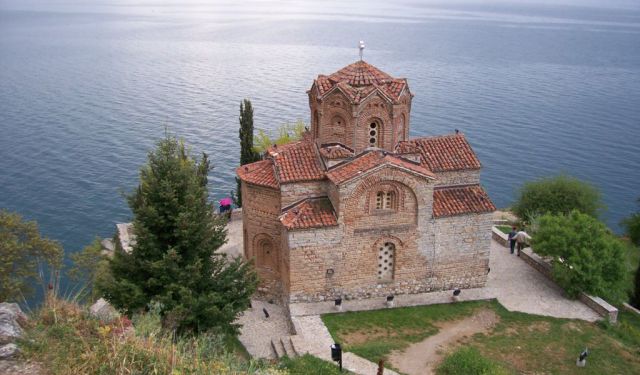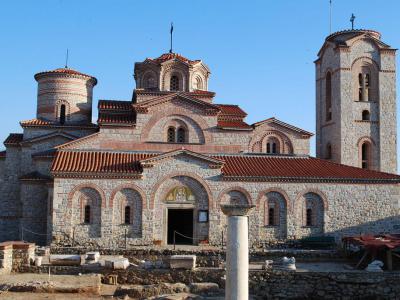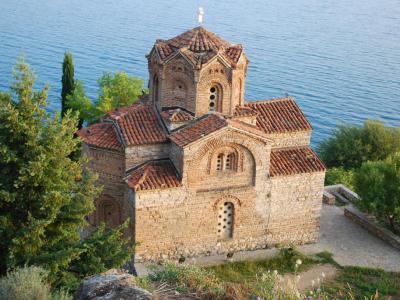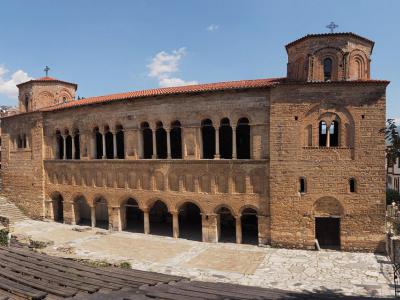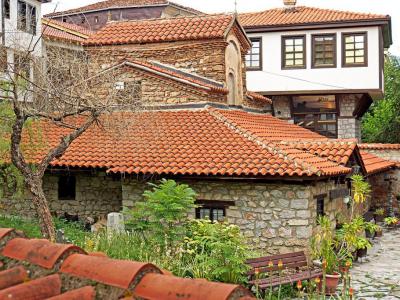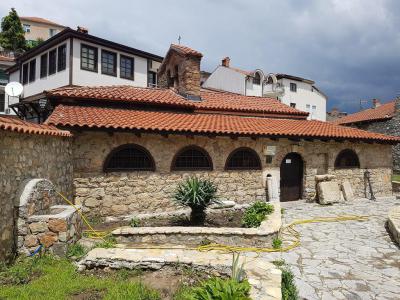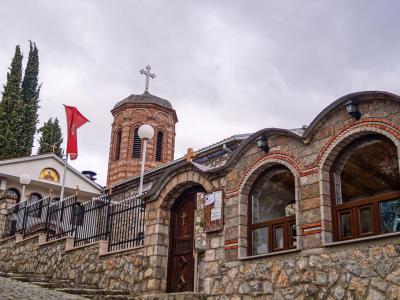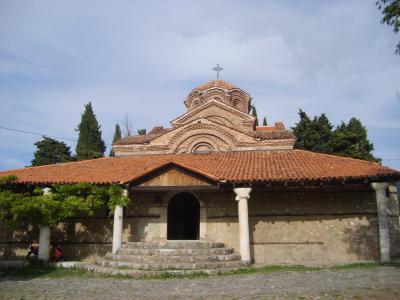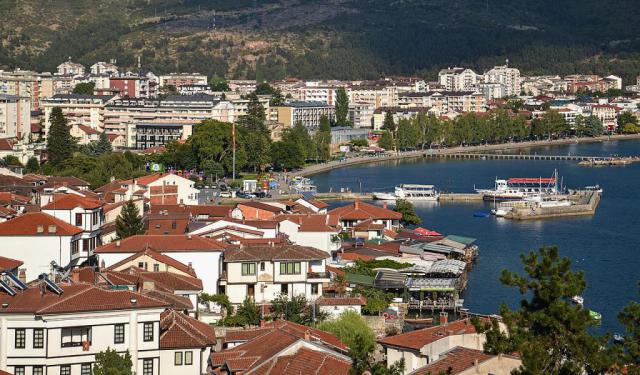Ohrid's Historical Churches (Self Guided), Ohrid
According to the legend based on the observations of 15th-century Ottoman traveler Evlia Celebia, the town of Ohrid used to have within its boundaries 365 chapels – one for every day of the year. At some point during Medieval times, Ohrid was even dubbed Slavic Jerusalem. Today, although the number of churches is considerably smaller, the architectural and historical value of those that remain make this charming town in North Macedonia just as interesting a destination, from the ecclesiastical standpoint, as ever.
One of the most prominent local churches is that of Saints Clement and Panteleimon. A stunning example of Byzantine architecture, the current building replaces the original church that stood here since the 9th century. Its elaborate mosaics and ornate designs captivate visitors, offering a glimpse into the region's religious and artistic past.
Nearby, overlooking the azure waters of Lake Ohrid, stands the Church of Saint John at Kaneo, a picturesque gem perched on a cliff. Dating back to the 13th century, this small yet magnificent church is famed for its remarkable frescoes and breathtaking views, making it a must-visit for tourists and pilgrims alike.
Venturing further along the coastline, one encounters the elegant Church of Saint Sophia, an architectural masterpiece from the 11th century. Its graceful appearance and intricate frescoes reflect the Byzantine influence, while its serene atmosphere invites contemplation and reflection.
Not far away, you can see the Church of Saint Bogorodica Bolnicka, renowned for its exquisite wood-carved iconostasis and serene ambiance. Adjacent to it, the Church of Saint Nicholas Bolnicki is a testament to medieval craftsmanship and spiritual devotion.
Further exploring Ohrid's religious heritage reveals the Holy Virgin Mary Kamensko, a charming church nestled amidst secular constructions, offering solace to weary souls seeking tranquility.
Lastly, one cannot miss the Saint Bogorodica Perivlepta Church, adorned with stunning frescoes and intricate decorations, showcasing the artistic prowess of the Byzantine era.
Ohrid's historical churches are not merely architectural marvels but also repositories of the region's religious heritage. Visiting them is an opportunity for spiritual enrichment and cultural appreciation. Follow our self-guided tour for a memorable experience, resonating with the echoes of centuries past.
One of the most prominent local churches is that of Saints Clement and Panteleimon. A stunning example of Byzantine architecture, the current building replaces the original church that stood here since the 9th century. Its elaborate mosaics and ornate designs captivate visitors, offering a glimpse into the region's religious and artistic past.
Nearby, overlooking the azure waters of Lake Ohrid, stands the Church of Saint John at Kaneo, a picturesque gem perched on a cliff. Dating back to the 13th century, this small yet magnificent church is famed for its remarkable frescoes and breathtaking views, making it a must-visit for tourists and pilgrims alike.
Venturing further along the coastline, one encounters the elegant Church of Saint Sophia, an architectural masterpiece from the 11th century. Its graceful appearance and intricate frescoes reflect the Byzantine influence, while its serene atmosphere invites contemplation and reflection.
Not far away, you can see the Church of Saint Bogorodica Bolnicka, renowned for its exquisite wood-carved iconostasis and serene ambiance. Adjacent to it, the Church of Saint Nicholas Bolnicki is a testament to medieval craftsmanship and spiritual devotion.
Further exploring Ohrid's religious heritage reveals the Holy Virgin Mary Kamensko, a charming church nestled amidst secular constructions, offering solace to weary souls seeking tranquility.
Lastly, one cannot miss the Saint Bogorodica Perivlepta Church, adorned with stunning frescoes and intricate decorations, showcasing the artistic prowess of the Byzantine era.
Ohrid's historical churches are not merely architectural marvels but also repositories of the region's religious heritage. Visiting them is an opportunity for spiritual enrichment and cultural appreciation. Follow our self-guided tour for a memorable experience, resonating with the echoes of centuries past.
How it works: Download the app "GPSmyCity: Walks in 1K+ Cities" from Apple App Store or Google Play Store to your mobile phone or tablet. The app turns your mobile device into a personal tour guide and its built-in GPS navigation functions guide you from one tour stop to next. The app works offline, so no data plan is needed when traveling abroad.
Ohrid's Historical Churches Map
Guide Name: Ohrid's Historical Churches
Guide Location: North Macedonia » Ohrid (See other walking tours in Ohrid)
Guide Type: Self-guided Walking Tour (Sightseeing)
# of Attractions: 7
Tour Duration: 1 Hour(s)
Travel Distance: 2.7 Km or 1.7 Miles
Author: gene
Sight(s) Featured in This Guide:
Guide Location: North Macedonia » Ohrid (See other walking tours in Ohrid)
Guide Type: Self-guided Walking Tour (Sightseeing)
# of Attractions: 7
Tour Duration: 1 Hour(s)
Travel Distance: 2.7 Km or 1.7 Miles
Author: gene
Sight(s) Featured in This Guide:
- Church of Saints Clement and Panteleimon
- Church of St. John at Kaneo
- Church of St. Sophia
- The Church of St. Bogorodica Bolnicka
- The Church of St. Nicholas Bolnicki
- Holy Virgin Mary Kamensko
- St. Bogorodica Perivlepta Church
1) Church of Saints Clement and Panteleimon
The Church of Saints Clement and Panteleimon, located in Ohrid, is a significant Byzantine architectural monument and an important historical and religious site. Attributed to Saint Clement of Ohrid, a disciple of Saint Cyril and Saint Methodius, this church stands on the grounds believed to be where the first students of the Glagolitic alphabet were educated. These teachings facilitated the translation of the Bible into Old Church Slavonic during the First Bulgarian Empire.
Saint Clement arrived in Ohrid under the commission of Boris I of Bulgaria. Upon his arrival, Clement restored an existing old church. However, dissatisfied with its size, he decided to construct a new church over the old structure, dedicating it to Saint Panteleimon. This new establishment not only served as a church but also as a monastery, which Clement possibly designed himself. Alongside Naum of Preslav, another disciple of Cyril and Methodius, Clement used this monastery as a hub for teaching the Glagolitic and Cyrillic alphabets to the newly Christianized Slavs. This educational activity effectively turned the monastery into what is considered the first and oldest discontinued university in Europe.
Architecturally, the church reflects its intended purpose as a literary school, with its design emphasizing educational and monastic functions. The exterior of the monastery is noted for its intricate mosaics and features a stone baptismal font, likely used by Clement to baptize his disciples. This combination of religious and educational elements underscores the church's historical significance as a center for religious teaching and Slavic literacy during the Byzantine period.
Saint Clement arrived in Ohrid under the commission of Boris I of Bulgaria. Upon his arrival, Clement restored an existing old church. However, dissatisfied with its size, he decided to construct a new church over the old structure, dedicating it to Saint Panteleimon. This new establishment not only served as a church but also as a monastery, which Clement possibly designed himself. Alongside Naum of Preslav, another disciple of Cyril and Methodius, Clement used this monastery as a hub for teaching the Glagolitic and Cyrillic alphabets to the newly Christianized Slavs. This educational activity effectively turned the monastery into what is considered the first and oldest discontinued university in Europe.
Architecturally, the church reflects its intended purpose as a literary school, with its design emphasizing educational and monastic functions. The exterior of the monastery is noted for its intricate mosaics and features a stone baptismal font, likely used by Clement to baptize his disciples. This combination of religious and educational elements underscores the church's historical significance as a center for religious teaching and Slavic literacy during the Byzantine period.
2) Church of St. John at Kaneo (must see)
The Church of Saint John the Theologian sits on a cliff overlooking Kaneo Beach and Lake Ohrid. It is really next door to the Plaosnik Archeological Site and Saint Clement's Church. The John referred to is John of Patmos, credited to be the writer of Revelations. According to some historians, he may also have been John the Apostle.
It is not known precisely when the church was built. Certain documents indicate construction was perhaps in the 13th century, well before the rise of the Ottoman Empire which eventually engulfed Macedonia.
The church is laid out in a cruciform plan on a rectangular base. Unfortunately, the architect is not yet known. The church has a single dome. The roof cornice is unusual. It is neither flat nor undulating in the normal manner. It forms angled tympanums between a doorway lintel and the arch above. This is customary in the central Balkans.
Frescoes dating from the 1200s are intact in the dome apse. The naos niche contains bits from the Passion of Christ. The altar space holds scenes of the liturgy and the Worship of the Lamb. There are portraits of Saints Clement of Ohrid, Erasmus of Lychnidos and Constantine Cabasilas, Ohrid Archbishop in the 1260s.
Christ Pancrator is featured in a fresco in the church dome. The Church of Saint John is a pleasant walk from the fortress of Tsar Samoil downhill through the pine forest. The views of Lake Ohrid and the old town are sweeping and dramatic. For weary, hungry hikers there is no dearth of friendly restaurants at the water's edge.
It is not known precisely when the church was built. Certain documents indicate construction was perhaps in the 13th century, well before the rise of the Ottoman Empire which eventually engulfed Macedonia.
The church is laid out in a cruciform plan on a rectangular base. Unfortunately, the architect is not yet known. The church has a single dome. The roof cornice is unusual. It is neither flat nor undulating in the normal manner. It forms angled tympanums between a doorway lintel and the arch above. This is customary in the central Balkans.
Frescoes dating from the 1200s are intact in the dome apse. The naos niche contains bits from the Passion of Christ. The altar space holds scenes of the liturgy and the Worship of the Lamb. There are portraits of Saints Clement of Ohrid, Erasmus of Lychnidos and Constantine Cabasilas, Ohrid Archbishop in the 1260s.
Christ Pancrator is featured in a fresco in the church dome. The Church of Saint John is a pleasant walk from the fortress of Tsar Samoil downhill through the pine forest. The views of Lake Ohrid and the old town are sweeping and dramatic. For weary, hungry hikers there is no dearth of friendly restaurants at the water's edge.
3) Church of St. Sophia (must see)
The Cathedral of Saint Sophia was built in Ohrid in the 9th century by Boris II. It was rebuilt in the 11th century and provided with a domed basilica by Archbishop Leo of Ohrid. A Great Feast mural adorns the nave.
In the recess of the apse the Virgin Enthroned holds her son in a protective mandorla. Christ prepares bread and wine below. On the walls behind the altar platform (the "bema") is a sequence of scenes from the lives of Abraham, Saint Basil the Great and Saint John Chrysostum. Above the alcove where sacerdotales are kept are scenes of martyrdoms.
The church was dedicated to Holy Wisdom ("Hagia Sofia"). It was built on the foundation of an early Christian basilica of the 5th century. In the 15th century the church was converted to a mosque. The precious frescoes were white-washed. During their regime, the Ottomans caused a lot of damage to the church.
After the Balkan Wars of 1912, Saint Sophia was returned to her role as an Orthodox Church and a conservation project was initiated. The frescoes were cleaned and rejuvenated and the church once again expressed the Byzantine world of the 11th century.
Every year the one-month Ohrid Summer Festival is opened by an operatic concert at Saint Sophia's. The first concert was in August, 1961. Inside the church, Macedonian opera star Ana Lipsha Tofovic and pianist Ladislav Peridic gave a bravura performance. It was a first for Ohrid and a first for the church.
In the recess of the apse the Virgin Enthroned holds her son in a protective mandorla. Christ prepares bread and wine below. On the walls behind the altar platform (the "bema") is a sequence of scenes from the lives of Abraham, Saint Basil the Great and Saint John Chrysostum. Above the alcove where sacerdotales are kept are scenes of martyrdoms.
The church was dedicated to Holy Wisdom ("Hagia Sofia"). It was built on the foundation of an early Christian basilica of the 5th century. In the 15th century the church was converted to a mosque. The precious frescoes were white-washed. During their regime, the Ottomans caused a lot of damage to the church.
After the Balkan Wars of 1912, Saint Sophia was returned to her role as an Orthodox Church and a conservation project was initiated. The frescoes were cleaned and rejuvenated and the church once again expressed the Byzantine world of the 11th century.
Every year the one-month Ohrid Summer Festival is opened by an operatic concert at Saint Sophia's. The first concert was in August, 1961. Inside the church, Macedonian opera star Ana Lipsha Tofovic and pianist Ladislav Peridic gave a bravura performance. It was a first for Ohrid and a first for the church.
4) The Church of St. Bogorodica Bolnicka
The Church of Saint Bogorodica Bolnicka, located in Ohrid, is a historical and architectural treasure with a rich yet enigmatic history. Although the exact date of its construction remains unconfirmed, architectural analysis and interior designs suggest it was built around the 14th century. Positioned near the Lower Gate of the old city, this church once served a pivotal role during outbreaks of the Black Death, acting as a quarantine station for visitors who were required to isolate for 40 days before entering the town.
The name "Bolnicka," meaning "of the hospital" in Macedonian, reflects its transformation into a hospital post the arrival of the Turks. This adaptation of the church's dormitories into medical facilities marks a significant chapter in its history, aligning with its namesake opposite Saint Mary's Hospital.
Despite numerous renovations over the centuries, Saint Bogorodica Bolnicka preserves original frescoes from the 16th century within its walls. These artistic treasures are complemented by a 19th-century iconostasis, adding layers of cultural and historical depth. The frescoes, some of which were added as recently as 1834, indicate multiple periods of artistic expression and preservation efforts.
Local folklore adds a mysterious aura to the church, with legends suggesting the presence of dark corridors beneath the structure, purportedly home to malevolent forces. Tragic events during baptisms and weddings have fueled these myths, leading to a longstanding prohibition against conducting Mass or other ceremonies within its walls, a ban documented as early as 1694.
Despite its small size, the Church of Saint Bogorodica Bolnicka stands as a testament to the medieval architectural and artistic styles prevalent during its presumed period of construction. Today, it is recognized not only for its historical significance but also as a testament to the enduring spiritual and communal life of Ohrid through the ages.
The name "Bolnicka," meaning "of the hospital" in Macedonian, reflects its transformation into a hospital post the arrival of the Turks. This adaptation of the church's dormitories into medical facilities marks a significant chapter in its history, aligning with its namesake opposite Saint Mary's Hospital.
Despite numerous renovations over the centuries, Saint Bogorodica Bolnicka preserves original frescoes from the 16th century within its walls. These artistic treasures are complemented by a 19th-century iconostasis, adding layers of cultural and historical depth. The frescoes, some of which were added as recently as 1834, indicate multiple periods of artistic expression and preservation efforts.
Local folklore adds a mysterious aura to the church, with legends suggesting the presence of dark corridors beneath the structure, purportedly home to malevolent forces. Tragic events during baptisms and weddings have fueled these myths, leading to a longstanding prohibition against conducting Mass or other ceremonies within its walls, a ban documented as early as 1694.
Despite its small size, the Church of Saint Bogorodica Bolnicka stands as a testament to the medieval architectural and artistic styles prevalent during its presumed period of construction. Today, it is recognized not only for its historical significance but also as a testament to the enduring spiritual and communal life of Ohrid through the ages.
5) The Church of St. Nicholas Bolnicki
The Church of Saint Nicholas Bolnicki in Ohrid is a historical and architectural gem from the early 14th century. Built in 1313, it is located near the Lower Gate of Ohrid, close to Ohrid Port on Car Samuil Street, an area historically significant for its proximity to a hospital, hence the name "Bolnicki" derived from the Macedonian word for hospital "bolnica".
Architecturally, the church showcases a one-naval design, unique in the region of Ohrid for its simplicity and distinctiveness. It features semi-circular vaulting and a bell tower with a porch on the western side, influenced by the architectural styles of the Adriatic coast, marking it as unique within Macedonia.
The interior of the church is equally compelling, decorated with frescoes that date back to between 1336 and 1346. These artworks feature prominent historical figures such as Archbishop Nikola, Serbian King Dusan, his Queen Elena, and their sons Uros, Sava, and Simeon. Additionally, life-size representations of Saint Clement, Saint Nikola, and Saint Pantelejmon, along with the holy warriors Theodor Tiron and Stralitat, enrich the church’s cultural and religious significance. The church also houses valuable icons, including the litian icon dedicated to Saint Naum.
The Church of Saint Nicholas Bolnicki is not just a place of worship but a repository of history, bearing witness to the religious, cultural, and social transformations in Ohrid over the centuries. Its unique construction, using broken stones without bricks, and its artistic decoration with colorful paintings and icons make it a compelling destination for visitors and scholars alike. The surrounding courtyard, dotted with remnants from the Samuil Fortress that historically tumbled toward Lake Ohrid, adds to its historic charm and allure, making the church a must-visit during any tour of Ohrid’s rich ecclesiastical landscape.
Architecturally, the church showcases a one-naval design, unique in the region of Ohrid for its simplicity and distinctiveness. It features semi-circular vaulting and a bell tower with a porch on the western side, influenced by the architectural styles of the Adriatic coast, marking it as unique within Macedonia.
The interior of the church is equally compelling, decorated with frescoes that date back to between 1336 and 1346. These artworks feature prominent historical figures such as Archbishop Nikola, Serbian King Dusan, his Queen Elena, and their sons Uros, Sava, and Simeon. Additionally, life-size representations of Saint Clement, Saint Nikola, and Saint Pantelejmon, along with the holy warriors Theodor Tiron and Stralitat, enrich the church’s cultural and religious significance. The church also houses valuable icons, including the litian icon dedicated to Saint Naum.
The Church of Saint Nicholas Bolnicki is not just a place of worship but a repository of history, bearing witness to the religious, cultural, and social transformations in Ohrid over the centuries. Its unique construction, using broken stones without bricks, and its artistic decoration with colorful paintings and icons make it a compelling destination for visitors and scholars alike. The surrounding courtyard, dotted with remnants from the Samuil Fortress that historically tumbled toward Lake Ohrid, adds to its historic charm and allure, making the church a must-visit during any tour of Ohrid’s rich ecclesiastical landscape.
6) Holy Virgin Mary Kamensko
The Holy Virgin Mary Kamensko Church (Sveta Bogorodica Kamensko) is a significant Orthodox Christian sanctuary located in Ohrid. It operates under the Debar-Kicevo Metropolitanate of the Macedonian Orthodox Church - Ohrid Archdiocese. Nestled in the heart of Ohrid above Old Chinar, the church is a historic and cultural landmark believed to have been constructed in the 17th century.
Throughout its history, the church has undergone several expansions and renovations. An inscription on a stone block on the eastern exterior confirms an expansion in 1832. Further interior renovations were documented in inscriptions by Dicho Zograf, his son Avram Dichov, and Petar Ioanov during 1863-1864. The church's frescoes, pivotal to its artistic heritage, were restored in 1924 and underwent further cleaning and conservation by the Institute for the Protection of Cultural Monuments and the National Museum - Ohrid in 2002.
The church's iconostasis, crafted in 1845 by Debar master Dimitar Stanishev, features an intricate design with images of Saints Cyril and Methodius, Saint Clement of Ohrid, and Saint Athanasius on the royal doors. Another remarkable feature is the Assumption of the Blessed Virgin Mary throne icon by Georgi Manuel. The iconostasis, richly adorned and gilded in 1867 through the patronage of Stefan Trimce Rekali, showcases a blend of local flora and fauna scenes, culminating in an upper register decorated with dragons, a crucifix, and depictions of the Holy Virgin and Saint John the Theologian.
The church complex also includes an administrative building constructed in 1991 and various infrastructural improvements made in the early 2000s, including the painting of previously untouched sections, marble granite flooring, and an extension of the courtyard completed by 2006.
Visitors to the church can enjoy a small terrace in the backyard, which offers panoramic views of Ohrid, adding a spiritual and visual experience for those exploring this sacred site. The Holy Virgin Mary Kamensko Church stands not only as a place of worship but also as a testament to the rich religious and cultural tapestry of Macedonia.
Throughout its history, the church has undergone several expansions and renovations. An inscription on a stone block on the eastern exterior confirms an expansion in 1832. Further interior renovations were documented in inscriptions by Dicho Zograf, his son Avram Dichov, and Petar Ioanov during 1863-1864. The church's frescoes, pivotal to its artistic heritage, were restored in 1924 and underwent further cleaning and conservation by the Institute for the Protection of Cultural Monuments and the National Museum - Ohrid in 2002.
The church's iconostasis, crafted in 1845 by Debar master Dimitar Stanishev, features an intricate design with images of Saints Cyril and Methodius, Saint Clement of Ohrid, and Saint Athanasius on the royal doors. Another remarkable feature is the Assumption of the Blessed Virgin Mary throne icon by Georgi Manuel. The iconostasis, richly adorned and gilded in 1867 through the patronage of Stefan Trimce Rekali, showcases a blend of local flora and fauna scenes, culminating in an upper register decorated with dragons, a crucifix, and depictions of the Holy Virgin and Saint John the Theologian.
The church complex also includes an administrative building constructed in 1991 and various infrastructural improvements made in the early 2000s, including the painting of previously untouched sections, marble granite flooring, and an extension of the courtyard completed by 2006.
Visitors to the church can enjoy a small terrace in the backyard, which offers panoramic views of Ohrid, adding a spiritual and visual experience for those exploring this sacred site. The Holy Virgin Mary Kamensko Church stands not only as a place of worship but also as a testament to the rich religious and cultural tapestry of Macedonia.
7) St. Bogorodica Perivlepta Church
Saint Bogorodica Perivlepta Church, situated in the picturesque old city of Ohrid, just inside the Gorna Porta, is a testament to Byzantine architectural and artistic mastery from the 13th century. The church, built in 1295 and dedicated to the Virgin Mary, whose title "Perivlepta" means "the Omniscient and Clairvoyant," holds significant historical and cultural value. It stands as one of the oldest churches in Ohrid and once served as the cathedral of the Archbishopric of Ohrid during a time when Saint Sophia was converted into a mosque.
The church was commissioned by Progon Zgur, the son-in-law of Byzantine Emperor Andronicus II. It is renowned for its frescoes, which were restored in 2017, and painted by the master artists Michael and Eutychius. These frescoes are noted for their vivid biblical depictions and a pioneering style that incorporated elements of Renaissance art, such as realism and dynamics, although lacking in perspective. Uniquely, the figures in these frescoes are portrayed not in the traditional Byzantine manner-thin and emotionless-but as robust, healthy young men with a lifelike appearance, complete with red cheeks.
Michael and Eutychius, celebrated for being among the first Byzantine artists to sign their works, have left their signatures in 20 hidden locations throughout the church, including on the front columns of the sword and the cloth of two holy warriors. This innovative approach marked a significant shift in Byzantine art, moving away from its earlier phases to embrace more realistic and dynamic expressions, reflecting the last phase of Byzantine culture and incorporating elements of local folk customs.
In addition to its artistic significance, Saint Bogorodica Perivlepta is also a sanctuary of deep spiritual importance. It houses the remains of Saint Clement of Ohrid, a major disciple of saints Cyril and Methodius, and is known as a site where one of the most important icons on Macedonian territory was discovered. The church also features an icon gallery that highlights the founders' artistic achievements, offering superb views of the lake and Old Town from its terrace.
The church was commissioned by Progon Zgur, the son-in-law of Byzantine Emperor Andronicus II. It is renowned for its frescoes, which were restored in 2017, and painted by the master artists Michael and Eutychius. These frescoes are noted for their vivid biblical depictions and a pioneering style that incorporated elements of Renaissance art, such as realism and dynamics, although lacking in perspective. Uniquely, the figures in these frescoes are portrayed not in the traditional Byzantine manner-thin and emotionless-but as robust, healthy young men with a lifelike appearance, complete with red cheeks.
Michael and Eutychius, celebrated for being among the first Byzantine artists to sign their works, have left their signatures in 20 hidden locations throughout the church, including on the front columns of the sword and the cloth of two holy warriors. This innovative approach marked a significant shift in Byzantine art, moving away from its earlier phases to embrace more realistic and dynamic expressions, reflecting the last phase of Byzantine culture and incorporating elements of local folk customs.
In addition to its artistic significance, Saint Bogorodica Perivlepta is also a sanctuary of deep spiritual importance. It houses the remains of Saint Clement of Ohrid, a major disciple of saints Cyril and Methodius, and is known as a site where one of the most important icons on Macedonian territory was discovered. The church also features an icon gallery that highlights the founders' artistic achievements, offering superb views of the lake and Old Town from its terrace.
Walking Tours in Ohrid, North Macedonia
Create Your Own Walk in Ohrid
Creating your own self-guided walk in Ohrid is easy and fun. Choose the city attractions that you want to see and a walk route map will be created just for you. You can even set your hotel as the start point of the walk.
Ohrid Introduction Walking Tour
Ohrid was called "Lychnidos", meaning "City of Light." By the late 9th century, the town was referred to as "Ohrid." This is Slavic, meaning "on a hill." With its 365 churches, it was known as "Jerusalem of the Balkans."
Legend says King Cadmus, banished from Thebes, founded the town on a hill overlooking the lucid waters of Lake Ohrid. That may... view more
Tour Duration: 2 Hour(s)
Travel Distance: 2.3 Km or 1.4 Miles
Legend says King Cadmus, banished from Thebes, founded the town on a hill overlooking the lucid waters of Lake Ohrid. That may... view more
Tour Duration: 2 Hour(s)
Travel Distance: 2.3 Km or 1.4 Miles
The Most Popular Cities
/ view all
